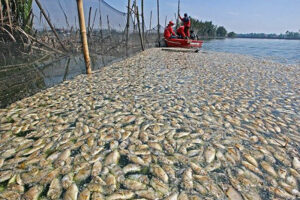Possible fish kill flagged when El Niño hits inland fish farms
THE Bureau of Fisheries and Aquatic Resources (BFAR) said on Wednesday that the El Niño dry spell could result in fish kills at inland aquaculture farms. “There will be lower water levels, (which means) a decrease to the dissolved oxygen,” said BFAR Spokesperson Nazario C. Briguera in a briefing. “This could indicate fish kill if […]

THE Bureau of Fisheries and Aquatic Resources (BFAR) said on Wednesday that the El Niño dry spell could result in fish kills at inland aquaculture farms.
“There will be lower water levels, (which means) a decrease to the dissolved oxygen,” said BFAR Spokesperson Nazario C. Briguera in a briefing.
“This could indicate fish kill if we cannot take the appropriate mitigating measures,” he added.
Farmed fish typically include tilapia and milkfish (bangus) but also shellfish.
According to the Food and Agriculture Organization, aquaculture has “grown faster than capture fisheries in the last two years” and is expected to expand further in the next decade.
“Our aquaculture represents 54% of the fisheries output and if you do not have (enough) water in your fish pen, it will affect the supply,” Danilo V. Fausto, president of Philippine Chamber of Agriculture and Food, Inc., told reporters by phone.
Last year, overall fisheries output rose 2.2% to 4.34 million metric tons (MT), according to the Philippine Statistics Authority.
This was driven by the growth in the marine municipal and aquaculture fisheries. Marine municipal fisheries and aquaculture accounted for 21.8% and 54.1% of overall output, respectively.
On Tuesday, the government weather service, known as PAGASA (Philippine Atmospheric, Geophysical and Astronomical Services Administration), issued an updated El Niño alert, saying the weather phenomenon is likely to persist until the first quarter of 2024.
To mitigate the impacts of El Niño, Mr. Briguera said fish farmers must avoid overstocking their ponds with fingerlings.
“Kung mababa ang iyong tubig, mataas ang competition for dissolved oxygen. Kung mag-o-overstock ka, definitely, very high ang probability for fish kill (Low water levels mean heightened competition for dissolved oxygen. An overstocked pond means a definite risk of fish kill)” he said.
Mr. Briguera said the warmer weather could result in growth for marine pelagic fisheries, noting that tuna and sardines grow well in warm ocean temperatures.
He said the government plans to distribute fish aggregating devices known as payao to compensate for any possible shift in fish migration patterns.
He said supply is sufficient for both aquaculture and marine fisheries, citing an internal rule of thumb based on the P200 per kilo price of galunggong, or round scad.
CROP SECTOR
Citing the PAGASA climate outlook, U-Nichols A. Manalo, director of the Department of Agriculture’s (DA) Field Operations Services office, said in a separate briefing that some of the major crop production areas are expected to be hit by El Niño.
Below normal rainfall is expected in October for the Cordillera Administrative Region, the Ilocos Region, the Cagayan Valley, Central Luzon, the National Capital Region, Calabarzon, Bicol, Mimaropa, the Western Visayas, the Eastern Visayas, and Caraga.
Mr. Manalo said the wet planting season is ongoing, shifting to the dry cropping season in the second half.
For rice and corn, he said the total area affected in the 2019 dry spell was around 357,000 hectares with lost volume of 618,845 MT, valued at P10.7 billion.
“In 2019, (El Niño) was categorized as ‘weak’ but it only (lasted) for seven months. The value of lost production was higher compared to previous years. We are hoping that the looming El Niño will not be that severe, but we are assuring that the DA is prepared,” he said.
Possible adjustments include shifting the planting calendar and better coordinate water management with the National Irrigation Administration and the Irrigator’s Association.
Mr. Manalo said the DA has requested an initial budget of P18 million for cloud seeding operations in areas mostly affected by El Niño. — Sheldeen Joy Talavera























